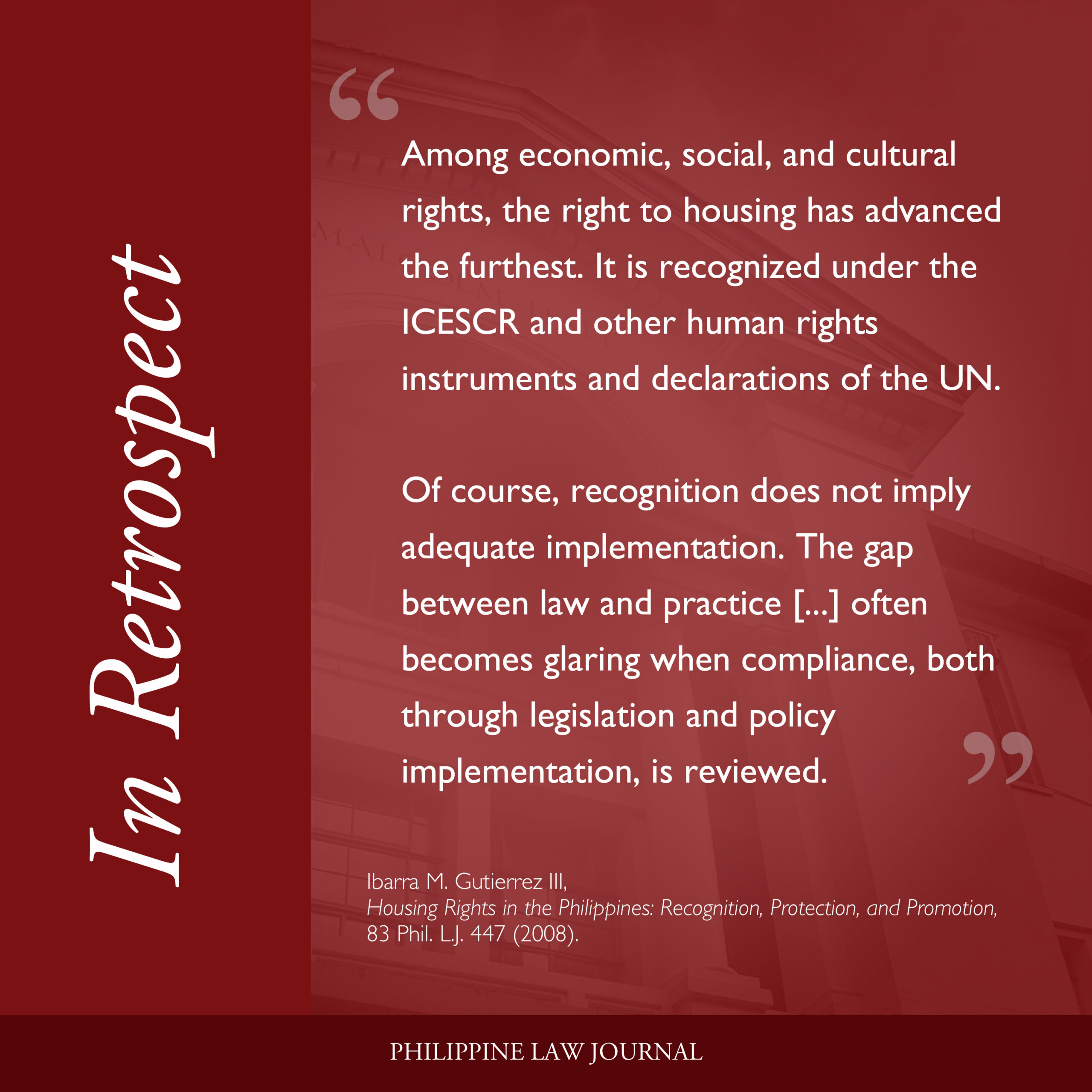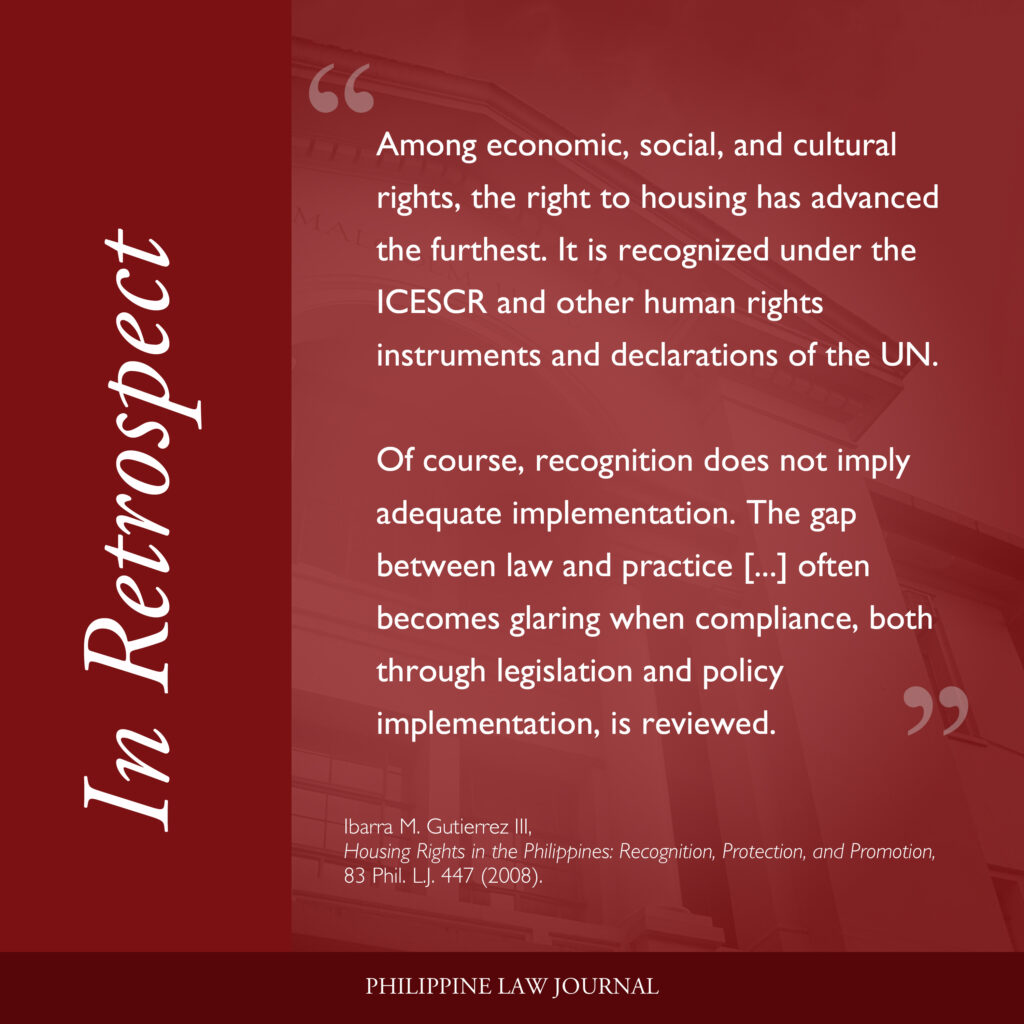Perspectives on the Right to Housing, 76 Years After the UDHR

Adopted in December of 1948, the Universal Declaration of Human Rights (“UDHR”) enshrines the right to an adequate standard of living, including housing,[1] as fundamental to human dignity. Yet, for millions of people worldwide—especially in urbanizing nations like the Philippines—this right remains elusive.
According to the Department of Human Settlements and Urban Development (DHSUD), the Philippines faced a staggering housing backlog of approximately 6.5 million units from 2017 to 2022.[2] This issue is most pronounced in urban centers like Metro Manila, where over 13 million people reside amidst a high concentration of informal settlements and substandard living conditions.
The first installment of the In Retrospect series in the PLJ Forum delves into critical legal academic works that underscore the challenges and opportunities in realizing this right. Their insights provide a nuanced understanding of housing rights, exploring their legal recognition, urban governance implications, and intersections with environmental and land use policies.

As early as 2008, Ibarra Gutierrez III provided an assessment of housing rights in the Philippines in his PLJ article Housing Rights in the Philippines: Recognition, Protection, and Promotion.[3] Gutierrez cites the Urban Development and Housing Act of 1992 (“UDHA”) as a direct response to the right to housing enshrined in both the UDHR and the International Covenant on Economic, Social, and Cultural Rights (“ICESCR”).[4] Through the UDHA, the Philippines committed itself to its international obligations by implementing an Urban Development and Housing Program that seeks to provide socialized housing on land secured by local governments, and on land required to be allotted by private developers for the purposes of socialized housing.
More pertinent to Gutierrez’s argument, however, was the other prominent feature of the UDHA—the protection against forced eviction. Gutierrez outlines that while eviction is generally prohibited under the UDHA, the statute’s listed exceptions have allowed courts to rule in ways that limit the protection against eviction. Courts have, for instance, invoked the laws against nuisance, the Local Government Code (“LGC”), and MMDA Resolutions as valid sources of authority for the government to conduct forcible evictions. He concludes that despite the enactment of the UDHA which ostensibly complies with the UDHA and ICESCR, the Philippines’ obligation to protect the right to housing has been left unfulfilled.
Since Gutierrez’s article came out 17 years ago, various other legal publications have contributed to the discussion on housing rights.
A 2022 article from the U.S.T. Law Review, for instance, tries to identify the root causes of housing inequality, which it traces to the lack of effective legal and institutional mechanisms for inclusive urban governance. In his article Ang Batas at ang Balai (The Law and the Home): Establishing the Right to the City as a Path Towards Liberty and Sustainable Prosperity,[5] Jyrus Cimatu notes that the commodification of housing prioritizes market value over its recognition as a human right essential for dignity, safety, and well-being. To address these challenges, he advocates for institutionalizing the Right to the City, a framework for inclusive and sustainable urban governance rooted in Philippine laws, jurisprudence, and international treaties. For instance, cases like Bayan v. Ermita[6] emphasize the need for public spaces to protect democratic freedoms, while the LGC mandates Comprehensive Land Use Plans (“CLUP”) aligned with the national development goals. Cimatu also proposes enacting a National Land Use Act to integrate citizen participation into land use planning and require sectoral committees in city charters. Additionally, he recommends judicial innovations like the Writ of Balai, a legal remedy to protect urban residents’ civil, political, and socio-economic rights.
Another interesting point of view presented in Volume 67 of Ateneo Law Journal was that of Antonio G.M. La Viña and Jameela Joy M. Reyes in their article Maladaptation, Loss and Damage, and the Built Environment: Limits and Possibilities.[7]Through the article, La Viña and Reyes shed light as to the maladaptive effects of the built environment. The authors note that while the built environment was designed in order to adapt to the changing needs of its inhabitants, these changes often result in increased vulnerability of the population towards environmental risks. La Viña and Reyes cite in particular two projects of the Duterte administration—the Kaliwa Dam project and the Pasig Expressway—as innovations which initially seem to benefit the public, but come at the expense of negative impacts on the environment. These environmental concerns, the authors stress, ought to be balanced against the growing and changing needs of human space.
The vision for inclusive urban governance espoused in local literature aligns with international discourse on housing rights, particularly the rights-based approaches being developed globally.
An article in the Harvard Law Review entitled Addressing Challenges to Affordable Housing in Land Use Law: Recognizing Affordable Housing as a Right[8] identifies restrictive zoning rules as the main land use barrier that prevents affordable housing. Through the impartial exercise of influence by zoning board members and the stringent standing requirements and standard of review for zoning decisions, zoning regulations tend to be a resilient obstacle in the fight for affordable housing. In response to this, the article proposes that the right to affordable housing be treated as a “negative” right against regulations that unjustifiably burden development of affordable housing. Thus, rather than directly providing housing, refraining from imposing these burdens is the primary duty of the government. The article asserts that this approach would provide a clear method of recourse for those who have been injured in their ability to construct or access affordable housing and encourage judicial oversight of zoning decisions. It argues that when courts are willing to enforce this right and provide individuals procedural protections, the possibility of unfavorable court decisions will encourage a municipality to promote affordable housing and settle before trial.
The article adds that a rights-based approach may also face less political opposition than piecemeal reforms because of the all-encompassing nature of a right, whereas reforms may be stymied on the way. When the right to housing is recognized, courts can develop a more robust procedural due process to protect it against infringement, whether by the state or by a private entity.
Ultimately, the perspectives offered by each of these works demonstrate that while the right to housing is a cornerstone of human dignity, its realization is hindered by inadequate policies, systemic inequalities, and misalignments in our environmental and planning paradigms. As the Philippines grapples with a significant housing backlog and the challenges of rapid urbanization, there is an urgent need to reframe housing as a fundamental human right. This entails bold reforms, inclusive governance, and sustainable development that would bridge the gap between legal frameworks and the realities faced by millions of Filipinos affected by the housing crisis.
* This In Retrospect was prepared by PLJ interns Jethro Camara, Ricah Pareja, Raven Gutierrez, and Troy Tarriela.
In Retrospect is a series of thought pieces revisiting past Journal articles in light of recent developments in current affairs or related literature. They are written by PLJ interns, with guidance from the Editorial Board.
[1] Universal Declaration on Human Rights [hereinafter “UDHR”] art. 30, Dec. 10, 1948, at https://www.un.org/sites/un2.un.org/files/2021/03/udhr.pdf.
[2] 6.5 million housing backlog, Manila Bulletin, Feb. 5, 2024, at https://mb.com.ph/2024/2/4/6-5-million-housing-backlog.
[3] Ibarra M. Gutierrez III, Housing Rights in the Philippines: Recognition, Protection, and Promotion, 83 PHIL. L.J. 447 (2008).
[4] International Convent on Economic, Social and Cultural Rights [hereinafter “ICESCR”] art. 11, Dec. 16, 1966, 993 UNTS 3.
[5] Jyrus B. Cimatu, Ang Batas at ang Balai (The Law and the Home): Establishing the Right to the City as a Path Towards Liberty and Sustainable Prosperity, 66 U.S.T. L. Rev. 211 (2022)
[6] 522 Phil. 201 (2006).
[7] Antonio G.M. La Viña and Jameela Joy M. Reyes, Maladaptation, Loss and Damage, and the Built Environment: Limits and Possibilities, 67 Ateneo L.J. 377 (2022).
[8] Note, Addressing Challenges to Affordable Housing in Land Use Law: Recognizing Affordable Housing as a Right, 135 Harv. L. Rev. 1105 (2022).